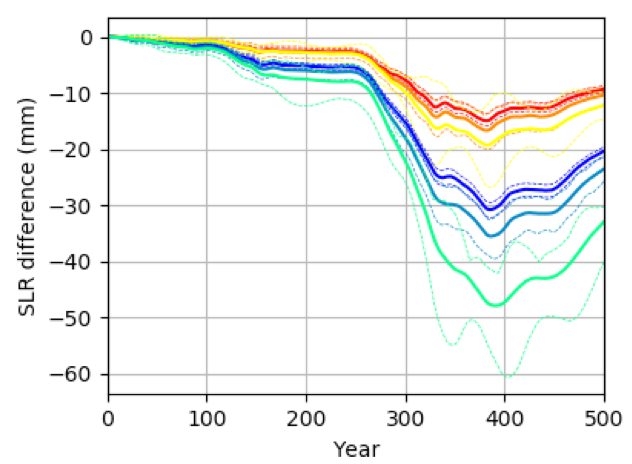Ocean Temperature Variability Causes Delays in Glacier Retreat

Example model output showing ice speed (top), applied melt rate (middle), and bed topography (bottom) during one simulation.
Background
Warm ocean water melts the floating extensions of the Antarctic Ice Sheet called ice shelves. While melting of ice shelves does not contribute to sea-level rise because they are already floating, the thinning of the ice shelves that this causes reduces their ability to hold back the flow of the grounded glaciers behind them. This causes faster ice flow to the ocean and sea level rise.
The retreat of marine glaciers in Antarctica is the greatest single source of uncertainty in future sea level rise projections. The glaciers in the Amundsen Sea sector of West Antarctica are particularly vulnerable to rapid, unstable retreat due to the presence of bed topography that deepens inland from the ocean and therefore may be subject to the so-called “marine ice sheet instability”. Recent ocean measurements around Antarctica have shown that the ocean temperature near West Antarctica has not been uniformly increasing but varies by a few degrees over years or decades, which may be unrelated to climate change. However, modeling studies of how much Antarctic glaciers will contribute to sea level rise have largely ignored these short-term fluctuations, due to lack of knowledge about how they affect ice shelf melt rates.

(a) Location map and model domain setup. Thwaites Glacier model domain area is colored by modeled ice surface speed in the initial condition. Black line is grounding line position. Gray line indicates ice shelf extent outside of the model domain. Thin white lines are contours of model mesh resolution. Inset map shows location of model domain in red within Antarctica. (b) Ice sheet surface speed observed by satellite (c) Optimized basal friction parameter, 𝛽 , used to minimize the misfit between modeled and observed surface velocity. (d) Bed topography in the vicinity of present-day Thwaites Ice Shelf. Blue line is the grounding line position after the 5-year relaxation procedure and is the initial condition for all simulations presented. Yellow line is the fixed calving front position in our simulations. Black dot identifies the deepest depth of the sill.
Modeling and observations suggest that West Antarctica’s Thwaites Glacier, which holds enough ice to raise global sea level by 65 cm, has begun unstable retreat. Concurrently, oceanographic observations have revealed substantial multiyear variability in the temperature of the ocean water driving retreat through melting of the ice shelf that restrains inland glacier flow. In this study, researchers investigate how the inclusion of climate variability affects the evolution of West Antarctica where unstable ice retreat is underway.
Approach and Results
Scientists performed 500 year model simulations of Thwaites Glacier, Antarctica using DOE’s MALI ice sheet model (see also Antarctic Ice Sheet Modeling Highlighted on BER Website). A new parameterization of sub-ice shelf melting forced by warm ocean waters was developed for this study to link ocean temperature changes to ice-shelf melting. Using an ensemble of 72 ice-sheet model simulations that include an idealized representation of ocean temperature variability, scientists found that variable ice-shelf melting causes delays in grounding line retreat, mass loss, and sea level contribution relative to steady forcing. Modeled delays are up to 43 years after 500 years of simulation, corresponding to a 10% reduction in glacier mass loss. Delays are primarily caused by asymmetric melt forcing in the presence of variability. For the “warm cavity” conditions beneath Thwaites Ice Shelf, increases in access of warm, deeper water are unable to raise water temperatures in the cavity by much, whereas increases in access of significantly colder, shallow water reduce cavity water temperatures substantially. This leads to lowered mean melt rates under variable ocean temperature forcing. Additionally, about one quarter of the mass loss delay is caused by a nonlinear ice dynamic response to varying ice-shelf thinning rate, which is amplified during the initial phases of unstable, bed-topography-driven retreat. Mass loss rates under variability differ by up to 50% from ensemble mean values at any given time.

Difference in sea level rise when ocean temperature variability is included in simulations. Warm colors are moderate magnitude variability with different frequencies. Cool colors are high magnitude variability.
Impact
Ice sheet model projections of sea level rise that ignore real-world climate variability are too large. Coupling ice sheet models to climate models will lead to more accurate sea-level projections. E3SM is at the forefront of this effort, recently acquiring the ability to simulate ocean circulation and melt fluxes beneath ice shelves. While remaining work of coupling ice sheet models is in development (for example, allowing locations in the model to transition from ice-sheet-covered to ocean-covered), studies like this one bridge the gap and provide a preview of ice sheet behavior to be expected in a fully coupled Earth system model context. This research shows that variability in the ocean temperatures near Thwaites Glacier leads to slower glacier retreat there.
Paper
Hoffman, M. J., Asay-Davis, X., Price, S. F., Fyke, J. and Perego, M. 2019. Effect of Subshelf Melt Variability on Sea Level Rise Contribution From Thwaites Glacier, Antarctica, J. Geophys. Res. Earth Surf., 124, 1–24, doi:10.1029/2019JF005155
Contact
Matthew J. Hoffman
Los Alamos National Laboratory
Funding
Programs
- Advanced Scientific Computing Research
- Scientific Discovery through Advanced Computing
- Earth System Model Development
Projects
- Probabilistic Sea-Level Projections from Ice Sheet and Earth System Models
- Energy Exascale Earth System Model


